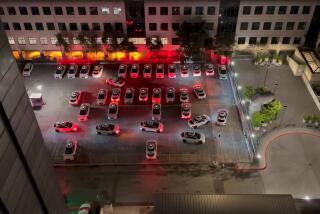A Road Annoyance That Occurs With Frequency
- Share via
Dear Street Smart:
I’d like to comment about a somewhat picayune annoyance that I wonder if many others don’t share with me. How many times have you been stuck in traffic under an overpass or in a tunnel, just as you were listening to the most important part of a radio program? Inevitably the radio goes dead just as they were to announce a ball game score, or as Paul Harvey is about to give you the “rest of the story.”
Many years ago, I was told that it would be a very simple thing to remedy that problem, just a matter of a few wires stretching along the inside of the underpass. I was reminded of that awhile ago when they were doing some work on El Toro under Interstate 5 and, all of a sudden, I noticed the radio program continued to come through loud and clear! I don’t know why, but there was all sorts of equipment parked along the underpass and I thought about the simple wire thing and wondered if their equipment included some communication wiring.
Am I the only one to worry about the radio blackouts? Has it been thought about? Or, isn’t the solution so simple? If there is a remedy, I’m sure a lot of commuters would appreciate it.
Lou Divelbiss
Laguna Hills
The reason your radio goes dead while you are driving through a tunnel is, quite simply, because the concrete blocks out the signal. This is much truer, however, for AM than for FM signals. That’s because low-frequency AM waves aren’t able to enter tunnels, while high-frequency FM waves generally can.
All this was explained by Ron Thompson, chief engineer for FM radio station KLON, which broadcasts from Long Beach.
Thompson also said there is some truth to what you heard about the problem being solved by wires along the inside of the underpass, although it isn’t nearly as simple as you heard. To be effective, he said, the wires would have to be connected to antennas outside the tunnel, which would pick up radio signals and relay them inside.
While that is sometimes done in subway or train tunnels to facilitate two-way emergency communications, it is generally considered impractical for freeway overpasses.
“These are natural or man-made constructions,” Caltrans spokeswoman Maureena Duran-Rojas said, “and Caltrans is not in the business of improving reception to the motoring public.”
The problem of radio blackouts, she said, has “never been brought to my attention as a problem. It always just seemed like a fact of life.”
Thompson said he thinks it just a coincidence that your car radio worked fine in the presence of freeway construction equipment. Most likely, he said, you were listening to FM or were very close to the transmitter.
And finally, you’re not the only one bothered by such inconveniences; Thompson said they drive him crazy too. “I totally identify,” he said. “Right when the baseball scores are coming is when you get stuck. Just when it’s something you’re really listening to, traffic backs up.”
His solution? “Avoid tunnels or listen to FM.”
Dear Street Smart:
Recently while driving, I noticed an ambulance driving along with its flashing red lights on, but it was obeying all traffic laws. It did not have its light bar emergency lights on, just the flashing red lights on the front and side of the van. What does that mean?
Mario Luna
Anaheim
“What that means to me,” says Dennis Shell, a spokesman for the Orange County Fire Authority, “is that the operator of that vehicle forgot to turn off all of his red lights.”
California law and his department’s policy is clear, Shell said: If an emergency vehicle is not racing to an emergency, it shouldn’t be flashing red lights.
Nonetheless, he said, when in doubt assume that any vehicle flashing its red lights is “on.”
“Just pull over to the right and yield,” he said. “Basically, it’s very dangerous not to.”
Street Smart appears Mondays in The Times Orange County Edition. Readers are invited to submit comments and questions about traffic, commuting and what makes it difficult to get around in Orange County. Include simple sketches if helpful. Letters may be published in upcoming columns. Please write to David Haldane, c/o Street Smart, The Times Orange County Edition, P.O. Box 2008, Costa Mesa, CA 92626, send faxes to (714) 966-7711 or e-mail him at David.Haldane@latimes.com. Include your full name, address and day and evening phone numbers. Letters may be edited, and no anonymous letters will be accepted.
More to Read
Sign up for Essential California
The most important California stories and recommendations in your inbox every morning.
You may occasionally receive promotional content from the Los Angeles Times.













